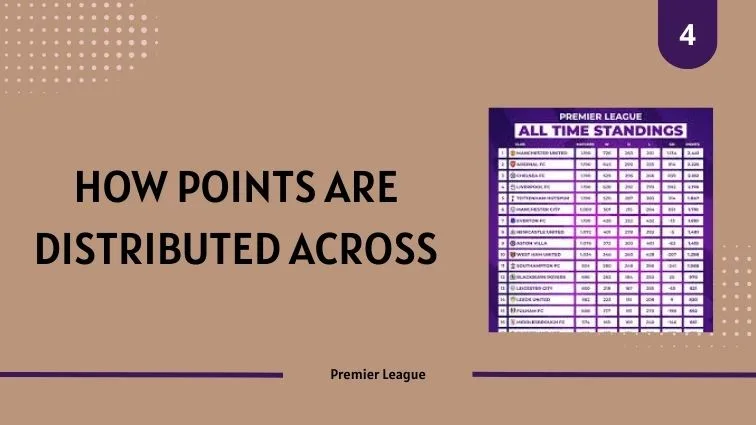The Premier League format involves each team playing 38 matches in a season, with points awarded for wins and draws. Team performance impacts final league standings.
Overview of Total Matches per Team in the Premier League

The Premier League format dictates a total of 38 matches per team over a football season. Each team competes against every other team twice, once at home and once away. This structure ensures that each of the 20 Premier League teams plays an equal number of home and away matches. The Premier League schedule is designed to accommodate these total matches in Premier League, leading to a comprehensive league system where each team’s performance can be fairly assessed. The 38-game season allows for a thorough evaluation of team capabilities, strategies, and overall endurance. Throughout this extensive series of EPL matches, teams strive to accumulate as many points as possible to advance in Premier League standings. This match structure forms the backbone of English football competition, emphasizing consistency and adaptability across the entire season.
Historical Context of the Premier League Match Structure
The Premier League, established in 1992, emerged from the restructuring of English football’s top tier. Initially comprising 22 teams, the league adopted a structure that saw each team play home and away matches against every other team. This format ensured fairness and comprehensive competition, laying the foundation for the modern Premier League schedule. In 1995, the league reduced to 20 teams, introducing the current 38-game season. The decision aligned with international standards, allowing Premier League teams to balance domestic commitments with European competitions. Over time, this structure has evolved, reflecting changes in the Premier League format and adapting to the growing demands of global football audiences. Today, the Premier League match structure is celebrated for its competitiveness and consistency, contributing significantly to the league’s reputation as one of the most exciting and dynamic leagues in world football.
Current Structure of EPL Matches
The current structure of EPL matches involves each of the 20 Premier League teams playing a total of 38 matches during the football season. This format includes two encounters against every other team, one at home and one away. Such an arrangement ensures a balanced competition, allowing teams to showcase their skills in varied environments. The league typically runs from August to May, with most Premier League fixtures scheduled over weekends. However, midweek games are also incorporated to accommodate all necessary matchdays within the football season. This structured approach provides predictability and fairness, ensuring that all clubs face equivalent challenges throughout the Premier League schedule. By maintaining this robust and consistent framework, the EPL continues to uphold its reputation as a thrilling and competitive league, drawing significant global attention and maintaining high standards of English football.
Comparison with Other Football Leagues’ Match Structures
The Premier League format, featuring a 38-game season, differs from many other top European leagues. For instance, the Spanish La Liga and the Italian Serie A also adhere to a similar structure, each comprising 20 teams playing 38 matches per season. Conversely, Germany’s Bundesliga includes 18 teams, resulting in a shorter 34-match campaign. France’s Ligue 1 operates with 18 teams as well, having recently reduced from 20, thus aligning more closely with the Bundesliga’s match frequency. These variations impact team strategies, player workload, and competitive dynamics across leagues. The EPL competition is renowned for its intensity and unpredictability, partly due to its balanced home and away schedule. While differences exist, the core principle of fair competition remains consistent across these leagues, ensuring that each team’s performance is measured equitably over the course of their respective football seasons.
Understanding the 38-Game Format in the Premier League

The 38-game format in the Premier League season is a cornerstone of its competitive structure, ensuring each team plays every other club twice. This arrangement promotes fairness and comprehensive assessment of team performance. The design allows clubs to experience diverse challenges at both home and away venues, testing their resilience and strategic adaptability. Such a format also supports a balanced distribution of fixtures across the football season, aligning with international standards observed in other major European leagues. Consequently, the Premier League schedule accommodates domestic and international commitments, providing teams the opportunity to compete on multiple fronts. The 38-game format has been instrumental in maintaining high engagement levels among fans, as the consistent match rhythm allows for anticipation and excitement throughout the year. Overall, this framework remains pivotal to the global appeal and success of English football.
Rationale Behind the 38-Game Season
The rationale for adopting a 38-game season in the Premier League is rooted in creating an equitable and comprehensive competition framework. By having each of the 20 teams play every other team twice, once at home and once away, the league ensures a balanced schedule that minimizes biases associated with venue advantages. This approach provides a robust platform for assessing team performance over time, as consistency and adaptability are tested across varied conditions. The format also aligns with European standards, facilitating synchronization with continental tournaments, such as the UEFA Champions League and Europa League. Furthermore, the 38-game structure maintains fan engagement through a steady stream of matches, fostering sustained interest throughout the football season. Overall, this well-considered format supports competitive integrity while promoting excitement, making it an integral part of the Premier League’s enduring global appeal.
Impact on Team Strategy and Preparation
The 38-game format of the Premier League season significantly influences team strategy and preparation. Clubs must meticulously plan to maintain peak performance across the entire football season, balancing player workload with tactical adjustments. This demands a comprehensive understanding of each opponent, as well as adaptability to various playing conditions encountered in both home and away matches. Coaches and managers often rotate squads to manage fatigue levels, ensuring key players remain fit for crucial fixtures. Additionally, the extended season necessitates strategic depth in terms of squad selection and injury management. The rigorous schedule also requires teams to analyze their Premier League fixtures meticulously, prioritizing certain matches to achieve optimal league points. Ultimately, the 38-game season challenges clubs to exhibit consistent excellence, making strategic foresight and meticulous preparation essential components of success in this highly competitive environment.
Adaptations in the Premier League Schedule
Over time, the Premier League schedule has undergone numerous adaptations to accommodate various factors affecting the football season. These include international tournaments, like the FIFA World Cup and UEFA European Championship, which necessitate adjustments to ensure minimal disruption. Additionally, television broadcasting requirements significantly influence match timings, often resulting in staggered kick-off times to maximize viewership. The league also considers domestic cup competitions, such as the FA Cup and EFL Cup, integrating these fixtures seamlessly within the 38-game season. Weather disruptions can lead to rescheduled matches, requiring efficient logistical planning. Furthermore, the growing demand for player welfare has prompted considerations for winter breaks, providing teams with much-needed rest periods. These adaptations reflect the dynamic nature of the Premier League format, ensuring it remains resilient and responsive to external influences while maintaining competitive balance and scheduling integrity.
Home and Away Games Structure in a Premier League Season

The Premier League structure incorporates a meticulously balanced home and away games framework, ensuring each team faces every other club twice throughout the season. This dual encounter system—once at the team’s home stadium and once at the opponent’s venue—results in 19 home and 19 away matches for each club. The alternating venues provide an equitable platform for assessing team performance, accounting for advantages associated with familiar surroundings and local fan support. Teams often leverage their home ground to maximize league points, strategically optimizing conditions to challenge visiting teams. Conversely, away games test adaptability and resilience, as clubs confront unfamiliar environments and hostile crowds. This home and away format is integral to the overall competitive balance of the EPL competition, compelling teams to strategize comprehensively to succeed across diverse match settings over the football season.
Importance of Home Advantage in EPL Competition
The concept of home advantage holds significant importance in EPL competition, influencing outcomes and strategies throughout the Premier League season. Playing on familiar turf provides clubs not only with logistical benefits, such as reduced travel fatigue but also psychological advantages. Home crowds offer vocal support, which can boost player morale and apply pressure on visiting teams. The familiarity with pitch dimensions, surface conditions, and environmental factors allows home teams to tailor tactics effectively. This advantage often translates into higher success rates at home matches, contributing crucially to overall league points accumulation. Consequently, maintaining a formidable home record is frequently pivotal in achieving favorable standings in the Premier League. Clubs invest significantly in creating an intimidating atmosphere for visitors, underscoring the strategic emphasis placed on maximizing home advantage within the highly competitive landscape of English football.
Challenges Faced During Away Matches
Away matches in the Premier League present distinct challenges that can impact team performance and overall success. Traveling to opponent venues involves logistical complexities, including long distances and varying travel conditions, which may contribute to player fatigue. Additionally, teams must adapt to unfamiliar pitch surfaces and dimensions, necessitating tactical adjustments. The absence of home support further compounds these challenges, as players contend with hostile crowds that can influence referee decisions and create psychological pressure. Communication among players is also tested in such environments due to the noise and atmosphere generated by opposing fans. These factors collectively make securing league points on the road a formidable task. Effective preparation and mental resilience are essential for teams looking to overcome these hurdles and perform consistently in away fixtures, ultimately influencing their positioning in the Premier League standings.
Influence on Premier League Standings
The dynamics of home and away matches play a crucial role in shaping Premier League standings. Teams with strong home records often amass significant league points, leveraging familiar conditions and fan support to secure victories. Conversely, performance in away games can be the differentiator for clubs vying for top positions. The ability to earn points on the road demonstrates adaptability and resilience, key factors in maintaining competitive advantage throughout the football season. Variations in outcomes between home and away fixtures frequently reflect in the league table, influencing qualification for European competitions and relegation battles. Clubs that consistently perform well in both settings are likely to achieve higher finishes, highlighting the importance of strategic planning and squad depth. Analyzing EPL matches across different venues provides insights into team strengths and weaknesses, contributing to the broader narrative of the English football league system.
How Points Are Distributed Across the Premier League Season

The Premier League structure employs a straightforward points system to determine standings throughout the football season. Teams earn three points for a win, one point for a draw, and no points for a loss. This system incentivizes attacking play and strategic risk-taking, as clubs aim to secure maximum points from each fixture. Consistently accumulating league points is crucial for maintaining competitive positioning within the Premier League standings, impacting both title aspirations and relegation battles. The cumulative nature of the 38-game season means that even minor fluctuations in performance can lead to significant shifts in table rankings. Consequently, understanding how points are distributed provides insights into team strategies and long-term planning. Clubs often analyze past results to optimize future match outcomes, emphasizing the importance of consistency and resilience across all Premier League games per team in achieving desired objectives.
Points System and Its Implications
The Premier League’s points system is integral to its competition structure, directly influencing team strategies and outcomes across the season. Each victory earns a team three league points, promoting an emphasis on offensive play and securing wins. A draw results in one point, encouraging teams to consider defensive stability when necessary. No points are awarded for losses, underscoring the importance of avoiding defeat. This system not only determines standings but also impacts financial rewards and European qualification. Clubs aim to maximize points from every fixture, understanding that cumulative success dictates seasonal achievements. The implications extend beyond the immediate matchday, as consistency in point accumulation affects long-term planning and squad development. Teams must balance risk and reward, making tactical adjustments based on their position in the Premier League standings. Ultimately, mastering the points system is crucial for sustained success in English football.
Tiebreakers and Their Role in Final Standings
In the Premier League, tiebreakers are essential for determining final standings when teams finish with identical league points at the end of the season. The primary tiebreaker is goal difference, calculated by subtracting goals conceded from goals scored. This measure rewards teams with strong offensive and defensive records, emphasizing the importance of balanced team performance. If goal differences are equal, the next criterion is goals scored, further highlighting attacking prowess. In rare cases where teams remain level, head-to-head results between the tied clubs are considered. These tiebreakers ensure fair and decisive outcomes in EPL competition, impacting European qualification spots and relegation positions. Understanding and leveraging these criteria can influence strategic decisions throughout the season, as clubs aim to not only accumulate points but also optimize their overall goal metrics. Thus, tiebreakers play a crucial role in shaping the competitive landscape of English football.
Historical Changes in the Points System
The Premier League’s points system has undergone significant changes since English football’s inception, shaping the competitive landscape over time. Initially, clubs were awarded two points for a win and one point for a draw, a format aimed at rewarding victory but often leading to cautious play. In the 1981-82 season, a pivotal change occurred with the introduction of three points for a win. This adjustment incentivized attacking strategies, encouraging teams to pursue wins rather than settle for draws. The three-point system remains a cornerstone of EPL competition, prioritizing proactive and offensive gameplay. These historical changes reflect broader shifts in football philosophy, aligning the league with global standards and enhancing its appeal. By fostering competitive engagement and dynamic performances, the evolution of the points system continues to influence team performance and the pursuit of excellence in the Premier League standings.
Impact of Total Matches on Team Performance and League Standings

The total matches in the Premier League season significantly affect both team performance and final league standings. Each club plays 38 games, demanding consistent effort and strategic depth across a lengthy campaign. This rigorous schedule tests squad resilience, requiring effective rotation to maintain peak performance levels throughout. Injuries and fatigue can influence outcomes, making squad management crucial for sustained success. The Premier League format necessitates adaptability to different opponents and conditions, impacting how teams accumulate league points. Strong performances over many fixtures often correlate with higher positions in the Premier League standings, while inconsistent results can lead to mid-table obscurity or relegation battles. Ultimately, enduring the demands of the 38-game season is integral to achieving competitive objectives, emphasizing the importance of comprehensive planning and tactical acumen in navigating the complexities of English football.
Correlation Between Number of Games and Team Performance
The Premier League schedule, encompassing 38 matches per season, exerts a substantial influence on team performance. The extensive number of games requires clubs to demonstrate not only skill but also endurance and strategic depth. A team’s ability to perform consistently over numerous fixtures is often indicative of their standing in the league. As the season progresses, factors such as squad rotation, injury management, and tactical flexibility become pivotal. Clubs that adeptly handle these challenges tend to accumulate more league points, reflecting positively in the Premier League standings. Conversely, those unable to maintain performance levels may find themselves struggling against relegation or missing out on European qualifications. This correlation underscores the importance of long-term planning and adaptability. Ultimately, success in the English football league system hinges on maximizing outcomes across all scheduled EPL matches.
Strategies for Maintaining Consistency Across the Football Season
Consistency is vital in navigating the rigorous Premier League season, with each team playing 38 matches. To maintain steady performance, clubs must adopt strategic approaches encompassing squad rotation to manage player fatigue and injuries effectively. Emphasizing depth in the squad allows for seamless substitutions without compromising quality. Tactical versatility is crucial, enabling adaptations based on opponents and evolving match conditions. Rigorous training regimens focusing on fitness and skill development enhance player readiness. Additionally, psychological resilience is fostered through motivational support and mental conditioning, preparing teams for the pressures of competitive football. Analyzing match data aids in refining strategies, identifying areas for improvement. Continuous communication within the club ensures alignment on goals and tactics. These strategies collectively contribute to accruing crucial league points, impacting team performance and standings in the highly competitive English football environment.
Long-term Effects on English Football Club Success
The total matches in Premier League seasons significantly impact long-term success for clubs in English football. Sustained performance across multiple 38-game seasons enhances a club’s reputation and financial health, attracting sponsorships and talent. Consistent results lead to higher Premier League standings, facilitating qualification for European competitions and increasing revenue streams. Investment in player development and infrastructure becomes possible, furthering competitive edge. Clubs that maintain excellence over time build robust fan bases and global followings, reinforcing brand value and marketability. Such stability fosters a virtuous cycle of success, where achievements fuel resources that, in turn, support continued excellence. Conversely, failure to adapt strategically can lead to relegation, disrupting growth trajectories. Hence, the cumulative effect of each EPL competition season shapes a club’s legacy, underscoring the importance of strategic foresight and operational proficiency in achieving sustained success.

